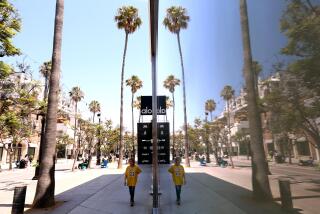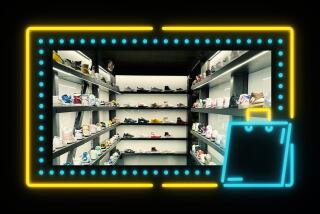Patricia Ward Biederman : The kids go round and round like so many zonked goldfish. : The mall is the suburbs’ answer to the street corner.
The mall rats of the West Valley go round and round the Byzantine interior of Topanga Plaza like so many zonked goldfish.
The mall is the suburbs’ answer to the street corner, with such welcome refinements as climate control and a roof. Whenever school is out, boys hang out here by the dozens, sharing a camaraderie so low key, so nonverbal, that it borders on the mute.
Although they have a clear choice, the Topanga regulars eschew nearby Woodland Hills Promenade. Its simple, elegant exterior is a warning bell. To teen-agers, simple elegance means clerical snootiness and slow food.
“Promenade is dog,” says one detractor. When pressed as to the precise nature of its doggie-ness, he compresses his nostrils and inquires, in a scathing imitation of fur-salon imperiousness, “May I help you?” The question is as solicitous as a karate chop.
The difference between the shopping centers is a matter of “class and level of boredom,” another articulate mall rat explains. “Promenade is this ritzy place with a whole bunch of clothes stores that nobody wants to go to. It has one tobacco store, one bookstore, six restaurants and a Saks Fifth Avenue ,” he says, as if the last explained everything.
Promenade does not shamelessly cater to the crowd that believes eating is an ambulatory activity and tipping is a sin. It is possible to masticate the entire time you are in Topanga Plaza. Promenade severely limits your opportunities to gulp bean burritos, egg rolls, double burgers and licorice whips in quick succession, wash them down with cherry Cokes and circle the mall while sucking the ice.
But, from a mall rat’s point of view, Promenade’s fatal flaw is that it has no arcade. As a result, one boy says, “Mostly girls go there.” Girls use the mall differently from boys, he explains. “Girls shop.”
The soul of Topanga Plaza is the Gold Mine arcade, less a business than a machine for extracting quarters from willing teens. Named with rare commercial candor, the Gold Mine has neither clocks nor windows. It is as remote from real-world time and obligations as a Las Vegas casino.
Only yesterday the guys at the Gold Mine were queuing up to give their allowances to Ms. Pac-Man. But video games have briefer careers than porn stars. This summer the game of the hour was Paperboy. Players flung electronic newspapers and broke electronic windows in a quest to keep the country safe from TV journalism. Today Gauntlet is the diversion on which everyone wants to lay his quarter reservation.
“I play, therefore I am” is the male manifesto of the mall. But there are other ways to kill time--ways usually resorted to only when a kid’s money is gone. You can sit with your pals on a bench and make wry observations just out of earshot of a passing security guard. You can go into Spencer Gifts and look at the weird stuff, like Fundies, underwear for two.
Topanga Pets attracts sun-dappled girls who evidently go there for the sole purpose of saying how cute the bunnies are. This attracts boys, who never say how cute anything is, let alone a bunny. Indeed, one male regular likes to loiter near the three-piece suits for dogs and refer to the rabbits as “Boa Chow.” “That’s guaranteed to get them riled,” he says, not referring to the rabbits.
Although the mall is clearly a place to meet girls, that isn’t its primary function.
Like the pool hall of another era, the neighborhood bar of another stage in life, the shopping center is a place for boys to be together. To an observer of another gender and generation, the young males are a composite chameleon. When giddy and playful, they are as winning as the bunnies at Topanga Pets. But there are moments when their remarkable energy turns sullen. You catch a whiff of menace coming off the pack and wonder what rough beast, its hour come round at last, slouches toward the Piercing Pagoda to be born.
An adult’s sense that something is amiss in a mall-centered universe is reinforced by William Severini Kowinski, who cruised 100 of the nation’s 2,000 major shopping centers, including Topanga and Promenade, before writing The Malling of America: An Inside Look at the Great Consumer Paradise . In this exhaustive mallography, Kowinski describes a disorder he calls “mallaise.” Victims experience a mild form of fear and loathing as a result of going to one mall too many, the same mall too often or identical malls in too many places. The poker-faced teens in Topanga Plaza all seem to have a low-grade case, although the miserable-looking married couples obviously get the worst attacks.
A little deviance goes a long way in so bland a setting. Their parents would die if they could see the eighth-grade girls who whisper approvingly at any man who looks sufficiently demented to have done time and has the tattoos to prove it.
Typically, though, nothing happens at the mall, except the occasional exhibit of late-model Jet-skies or program on the giddy pleasures of fire safety. Disturbingly little keeps the mall rats coming back for more.
But, then, the regulars don’t go to Topanga and other malls to be surprised. School is out, and, if they go to the mall, their friends will undoubtedly show up. If not friends exactly, people they can greet without rebuff, a grace at any age.
In the best of all possible worlds, the mall rats might chose another habitat. But, as one young Topanga regular explains, “I don’t have anyplace else to go.”
He says it as if it were not a tragedy.


